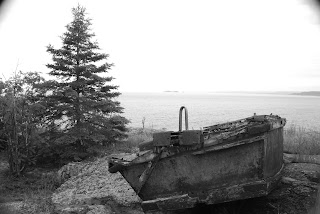
The streamlined hulls had better fuel efficiency and handled well in rough weather. They also had their drawbacks. They sat low in the water and were sometimes hard to see. Many were involved in collisions. Sailors didn't like them. In heavy seas with a low freeboard men were washed overboard. Even with these problems, Alexander McDougall's whalebacks became a success. In all, 44 whalebacks were built.
The Meteor was launched in 1896 as the Frank Rockefeller. She carried iron ore until 1927 when she was sold and renamed South Park . She hauled sand and other fill for the site of the 1933 Worlds Fair in Chicago. Later it was fitted with a deck to haul automobiles. The South Park foundered off of Manistique, Michigan in 1942. Although she was heavily damaged, she was sold to Cleveland Tankers Corporation and renamed Meteor. She was refitted to haul oil and petrochemicals. She was retired in 1969. Being the last working whaleback, she was a novelty around the ports of the Great Lakes. In 1972 the Meteor was towed back to the city where she was built, Superior, Wisconsin. It was opened as a museum in 1973.
 Dane Andree on the bridge.
Dane Andree on the bridge. The METEOR is the last Whaleback Ship
The METEOR is the last Whaleback Ship Even older Great Lakes ships have very sophisticated navigation systems like this gyroscopic compass and radio beacons.
Even older Great Lakes ships have very sophisticated navigation systems like this gyroscopic compass and radio beacons. The Meteor is "moored " on Barkers Island in Superior, Wisconsin. The tour was six dollars and was informative. If you're a boat nerd you need to check it out. For more info go to http://www.superiorpublicmuseums.org/ssmeteor/NewMETEORMAIN.htm
The Meteor is "moored " on Barkers Island in Superior, Wisconsin. The tour was six dollars and was informative. If you're a boat nerd you need to check it out. For more info go to http://www.superiorpublicmuseums.org/ssmeteor/NewMETEORMAIN.htm


 While hiking in Neys Provincial Park in Canada, Elaine and I ran across some abandoned wooden logging boats. We soon found out these old rotting boats had quite an interesting history.
While hiking in Neys Provincial Park in Canada, Elaine and I ran across some abandoned wooden logging boats. We soon found out these old rotting boats had quite an interesting history.


 State of Michigan auto ferry
State of Michigan auto ferry 
 On December 3, 1987, while being towed to Japan to be scrapped, the Gulf
On December 3, 1987, while being towed to Japan to be scrapped, the Gulf 






 H.T. POTT was built in 1933 at St. Louis and was the first all welded hull tow boat. She spent most of her time working around Kansas City, Missouri.
H.T. POTT was built in 1933 at St. Louis and was the first all welded hull tow boat. She spent most of her time working around Kansas City, Missouri.






 "Deer Plain"
"Deer Plain"




 She is a Showboat, with a huge 700 seat multi-tiered theater and galley serving gourmet meals. (Up to 2800 meals each day.) The SHOWBOAT BRANSON BELLE is operated by Silver Dollar City Entertainment. For information on lunch or dinner cruises visit
She is a Showboat, with a huge 700 seat multi-tiered theater and galley serving gourmet meals. (Up to 2800 meals each day.) The SHOWBOAT BRANSON BELLE is operated by Silver Dollar City Entertainment. For information on lunch or dinner cruises visit 



